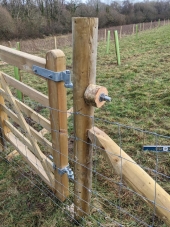

 1
1




How Permies works: https://permies.com/wiki/34193/permies-works-links-threads
My projects on Skye: The tree field, Growing and landracing, perennial polycultures, "Don't dream it - be it! "
 1
1




Visit Redhawk's soil series: https://permies.com/wiki/redhawk-soil
How permies.com works: https://permies.com/wiki/34193/permies-works-links-threads
 2
2




--
"Whitewashed Hope: A Message from 10+ Indigenous Leaders and Organizations"
https://www.culturalsurvival.org/news/whitewashed-hope-message-10-indigenous-leaders-and-organizations












 3
3




Jay Angler wrote:I haven't done this, but everything I've read and seen of deer, you need the hedge dense enough at the bottom that the deer won't push through rather than going over the top. In other words, several rows of shrubs with the plants off-set (diamond shaped). There's some cool techniques with plants that will "fuse to each other" where they tie the branches together in a crisscross. There's also the system from the British Isles called "laying a hedge", but that takes skills I don't have!

How Permies works: https://permies.com/wiki/34193/permies-works-links-threads
My projects on Skye: The tree field, Growing and landracing, perennial polycultures, "Don't dream it - be it! "
 4
4
















 1
1




William Bronson wrote:Since the post seem to be the issue , is there any chance you could grow replacements?
Black locust grown right along the fence line might work as a hedge and fence posts.
I don't know how it would deal with deer browse, but the volunteer locust in my front yard grew back to 8 feet plus after being cut to
below ground level.
How Permies works: https://permies.com/wiki/34193/permies-works-links-threads
My projects on Skye: The tree field, Growing and landracing, perennial polycultures, "Don't dream it - be it! "
 2
2




I'm currently reading, "Coppice Agroforestry" by Mark Krawczyk and those are the two plants specifically recommended for hedges for managing animal incursions/escapes, so it sounds as if you're on the right track!Nancy Reading wrote: At the moment I'm thinking hawthorn and blackthorn (sloe) as the main shrubs. Nothing really grows that fast here, but those are both survivors, and the blackthorn at least I have plenty of suckers from my existing plants making the hedge propagation free.
Visit Redhawk's soil series: https://permies.com/wiki/redhawk-soil
How permies.com works: https://permies.com/wiki/34193/permies-works-links-threads
 4
4




 3
3




William Bronson wrote:I hadn't considered the issue of wire embedded in timber.
I suppose I assumed one would cut around it
Visit Redhawk's soil series: https://permies.com/wiki/redhawk-soil
How permies.com works: https://permies.com/wiki/34193/permies-works-links-threads
 2
2





|
All of the world's problems can be solved in a garden - Geoff Lawton. Tiny ad:
2024 Permaculture Adventure Bundle (now a special for october 2025)
https://permies.com/w/bundle
|



